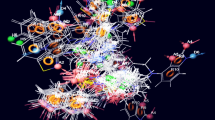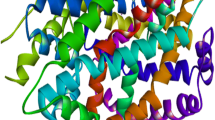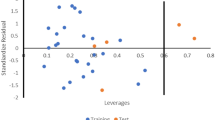Abstract
The inhibition of norepinephrine transporter (NET) plays an important role in the treatment of a psychiatric disorder. The present work employed a fast, simple, accurate and cost-effective cheminformatics approach using computer-aided structured-based drug design (SBDD) technique to complement our previous study. From our previous work, compound 2 was selected as the template compound for the design because of its better biological activity, lied within the applicability domain of the developed model and above all, it possessed good pharmacological attributes. As a consequence, Ten (10) hypothetical compounds were designed with better pharmacological properties as potential antipsychotic agents when compared the results with a standard drug (Atomoxetine). All the designed compounds displayed optimal molecular interactions with significant binding affinities (ranges from − 7.2 to − 7.6 kcal/mol) toward the active site of the biological target. Besides, all the designed compounds possessed a higher number of hydrogen bonds which could be linked to the structural modification and incorporation of electrophilic substituents (NH2, –OH, –OCH3, –CH3, NO2, –CF3, –F and –Cl) at different positions in the pharmacophore of the template compound compared to the standard drug with a lower binding affinity of − 6.1 kcal/mol. An outstanding molecular interaction was observed in the designed compound 2i among the selected compounds which could be attributed to the presence of two strongly activating substituents (–OH and −OCH3) at the ortho and meta positions in the pharmacophore (–Chlorophenyl) of the compound. Similarly, drug-likeness and bioavailability assessments revealed that none of the designed compounds including the standard drug violates the criteria stipulated by Lipinski’s rule of five. Likewise, the ADMET/Pharmacokinetics investigations showed that all the designed compounds possessed outstanding pharmacological properties, good oral bioavailability, excellent human gastrointestinal absorption a remarkable blood–brain barrier (BBB) permeability evidenced from the BOILED Egg graphics. More so, toxicity evaluation of the selected compounds showed that all the selected compounds are non-AMES mutagenicity and non-carcinogenicity. Interestingly, none of the selected compounds portend to be a human ether-a-go-go-related gene (hERG) cardiovascular toxicity. Hence, it is envisaged that the present study would serve as a promising prototype for further in vivo and experimental investigations in the discovery and development of more potent antipsychotic drugs.







Similar content being viewed by others
References
Babatunde S, Adamu O, Gideon U, Sani S (2020) QSAR modeling, molecular docking and ADMET/pharmacokinetic studies: a chemometrics approach to search for novel inhibitors of norepinephrine transporter as potent antipsychotic drugs. J Iran Chem Soc 17(8):1953–1966
Dessalew N (2009) QSAR study on dual SET and NET reuptake inhibitors: an insight into the structural requirement for antidepressant activity. J Enzyme Inhib Med Chem 24(1):262–271
Peruskovi’c DS, Stevanovi’c NR, Loli’c AD, Nikoli’c MR, Baosi’c RM (2014) Quantitative structure-activity relationship study of some antipsychotics by multiple linear regressions. Am J Anal Chem 5:335–342
Kapur S, Agid O, Mizrahi R, Li M (2006) How antipsychotics work—from receptors to reality. NeuroRx 3(1):10–21
Olasupo SB, Uzairu A, Shallangwa G, Uba S (2019) QSAR analysis and molecular docking simulation of norepinephrine transporter (NET) inhibitors as anti-psychotic therapeutic agents. Heliyon 5(10):e02640
Schlessinger A et al (2011) Structure-based discovery of prescription drugs that interact with the norepinephrine transporter, NET. Proc Natl Acad Sci 108(38):15810–15815
Olasupo SB, Uzairu A, Adamu GS, Uba S (2020) Computational modeling and pharmacokinetics/ADMET study of some arylpiperazine derivatives as novel antipsychotic agents targeting depression. Chem Afr 1–10. https://doi.org/10.1007/s42250-020-00161-4
Bhat S, Newman AH, Freissmuth M (2019) How to rescue misfolded SERT, DAT and NET: targeting conformational intermediates with atypical inhibitors and partial releasers. Biochem Soc Trans 47(3):861–874
Tareq Hassan Khan M (2010) Predictions of the ADMET properties of candidate drug molecules utilizing different QSAR/QSPR modelling approaches. Curr Drug Metab 11(4):285–295
Lipinski CA, Lombardo F, Dominy BW, Feeney PJ (1997) Experimental and computational approaches to estimate solubility and permeability in drug discovery and development settings. Adv Drug Deliv Rev 23(1–3):3–25
Andricopulo AD, Salum LB, Abraham DJ (2009) Structure-based drug design strategies in medicinal chemistry. Curr Top Med Chem 9(9):771–790
Ferreira LG, Dos Santos RN, Oliva G, Andricopulo AD (2015) Molecular docking and structure-based drug design strategies. Molecules 20(7):13384–13421
Andersen J, Ringsted KB, Bang-Andersen B, Strømgaard K, Kristensen AS (2015) Binding site residues control inhibitor selectivity in the human norepinephrine transporter but not in the human dopamine transporter. Sci Rep 5:15650
Ounthaisong U, Tangyuenyongwatana P (2017) Cross docking study of flavanoids against tyrosinase enzymes using PyRx 0.8 virtual screening tool. TJPS 41
Daina A, Zoete V (2016) A boiled-egg to predict gastrointestinal absorption and brain penetration of small molecules. ChemMedChem 11(11):1117–1121
Yang H et al (2019) admetSAR 2.0: web-service for prediction and optimization of chemical ADMET properties. Bioinformatics 35(6):1067–1069
Daina A, Michielin O, Zoete V (2017) SwissADME: a free web tool to evaluate pharmacokinetics, drug-likeness and medicinal chemistry friendliness of small molecules. Sci Rep 7:42717
Rawn JD, Ouellette RJ (2018) Organic chemistry: structure, mechanism, synthesis. Academic Press, Cambridge
Aswathy L, Jisha RS, Masand VH, Gajbhiye JM, Shibi IG (2018) Design of novel amyloid β aggregation inhibitors using QSAR, pharmacophore modeling, molecular docking and ADME prediction. In Silico Pharmacol 6(1):12
Patil R, Das S, Stanley A, Yadav L, Sudhakar A, Varma AK (2010) Optimized hydrophobic interactions and hydrogen bonding at the target-ligand interface leads the pathways of drug-designing. PLoS One 5(8):e12029
Adeniji SE, Arthur DE, Abdullahi M, Haruna A (2020) Quantitative structure–activity relationship model, molecular docking simulation and computational design of some novel compounds against DNA gyrase receptor. Chem Afr 3(2):391–408
Lipinski CA (2016) Rule of five in 2015 and beyond: target and ligand structural limitations, ligand chemistry structure and drug discovery project decisions. Adv Drug Deliv Rev 101:34–41
Qian S-B, Waldron L, Choudhary N, Klevit RE, Chazin WJ, Patterson C (2009) Engineering a ubiquitin ligase reveals conformational flexibility required for ubiquitin transfer. J Biol Chem 284(39):26797–26802
Huang C, Zheng C, Li Y, Wang Y, Lu A, Yang L (2014) Systems pharmacology in drug discovery and therapeutic insight for herbal medicines. Brief Bioinform 15(5):710–733
Broccatelli F et al (2011) A novel approach for predicting P-glycoprotein (ABCB1) inhibition using molecular interaction fields. J Med Chem 54(6):1740–1751
Chen L, Li Y, Zhao Q, Peng H, Hou T (2011) ADME evaluation in drug discovery. 10. Predictions of P-glycoprotein inhibitors using recursive partitioning and naive Bayesian classification techniques. Mol Pharm 8(3):889–900
Acknowledgements
We wish to acknowledge members of the theoretical and physical chemistry group, the chemistry department, Ahmadu Bello University Zaria. We sincerely appreciate David Arthur, Abdulateef Jimoh, Abdulfatai Usman and Jonh Philip Ameji for their technical support and advice in the course of this study.
Funding
The authors received no direct funding for this study.
Author information
Authors and Affiliations
Corresponding author
Ethics declarations
Conflict of Interest
The authors pronounced they have no conflict of interest.
Ethical approval
This article does not contain any studies with human or animal subjects.
Rights and permissions
About this article
Cite this article
Olasupo, S.B., Uzairu, A., Shallangwa, G. et al. Conceptual Structure-Based Drug Design and Discovering of Novel Inhibitors of Norepinephrine Transporter (NET) as Potential Antipsychotic Agents for Mental Disorder. Chemistry Africa 4, 115–125 (2021). https://doi.org/10.1007/s42250-020-00208-6
Received:
Accepted:
Published:
Issue Date:
DOI: https://doi.org/10.1007/s42250-020-00208-6




